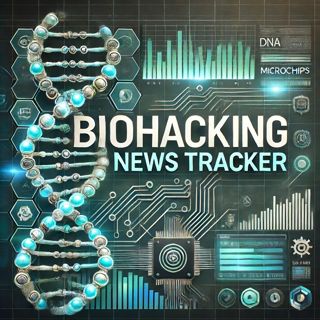
Biohacking Emerges as a Potential Game-Changer for Reducing Auto Insurance Costs for Poorer Drivers
Biohacking, a term that seems to be creating waves across various sectors, is increasingly showing its diverse range of implementations, from lifestyle enhancement to impacting broader, more systemic issues like insurance rates. At its core, biohacking involves tinkering with biology, through various means like genetic engineering, nutritional modifications, and electronic implants to optimize performance, enhance bodily functions, or even to simply alter one's lifestyle for the better.Interestingly, the concept has even found relevance in the world of auto insurance. Statistics have shown that poorer drivers end up paying up to 48% more for car insurance. The reasons for this surcharge can be multi-faceted, ranging from the higher risk associated with areas that have greater rates of accidents or thefts, to less stable credit scores which insurers use to gauge the reliability of a person. Biohacking could be a game-changer here as it can help individuals improve their cognitive functionalities and potentially their driving abilities.For those unaware, poorer areas also often suffer from factors like lesser access to healthy food options, greater environmental pollutants, and heightened stress levels, all of which can impact cognitive and physical health adversely. Biohacking approaches such as nutritional supplements, optimizing sleep, and stress management techniques can potentially offset these disadvantages to a certain extent. Better health through biohacked lifestyles could equate to better driving habits and record, which in turn could influence insurance rates positively.Apart from physical health, mental and emotional resilience, often enhanced through various biohacking techniques like meditation or neurofeedback, can significantly impact one's response time and decision-making processes, crucial skills in driving. A person who is biohacking might find themselves better able to manage the stress of driving in high-traffic conditions, or avoiding aggressive or reactive driving, which are often causes for accidents.This mentioned insight brings to light an often overlooked aspect of biohacking - its socio-economic implications. By potentially providing a means to improve individual health and behavior, biohacking could indirectly contribute to larger economic benefits for poorer communities who are currently paying a premium for being at a perceived higher risk, thanks primarily to factors beyond their control.éfonoMoreover, biohacking not only holds promise for person-centric benefits but could scale up to societal benefits, particularly evident in the context of auto insurance. The usage of biohacking techniques could very well become a recommended practice for risk mitigation, embraced by insurance agencies to incentivize healthier, safer lifestyles which could in turn justify lower premiums.However, it's crucial to approach biohocking with cautious optimism. As with any intervention that involves complex systems like human biology, there are risks involved. For instance, unregulated use of supplements could lead to harmful effects, while not all biohacking practices have been universally accepted or validated by the scientific community. Furthermore, there's a philosophical and ethical debate about the extent to which one should alter or enhance human capabilities.Biohacking's impact on reducing auto insurance costs for poorer drivers highlights an innovative cross-disciplinary benefit that goes beyond personal health and well-being. It exemplifies how emerging technologies and methodologies are increasingly interfacing with every facet of human life. While it's not a magic bullet, it certainly opens up a discussion for holistic approaches towards tackling systemic socio-economic challenges. As society shifts towards more personalized ways of managing health, well-being, and financial systems, biohacking stands out as a profound catalyst in bridging disparities, potentially making it a vital tool in the arsenal for addressing complex issues like inequality in insurance premiums.This content was created in partnership and with the help of Artificial Intelligence AI
21 Juli 20244min

Wealthy Biohacker Spends $2M Annually Chasing 18-Year-Old Vitality
Biohacking represents an emerging frontier in the realm of personal health and wellness where individuals apply a blend of medical, nutritional, physical, and electronic techniques to manipulate their biology, aiming to boost performance, enhance physical and mental health, and even reverse the effects of aging. A striking example of this trend involves a multimillionaire biohacker who reportedly spends $2 million a year in the pursuit of regaining the vitality and appearance reminiscent of an 18-year-old.This multimillionaire, often a figure cloaked in both affluence and intellectual curiosity, dives into the depths of anti-aging and wellness technologies that most can only dream of accessing. The strategies employed might include a wide-ranging spectrum from standard practices like intense dietary restrictions, regimes of complex supplements, and rigorous exercise routines to cutting-edge procedures like gene therapy, stem cell injections, regenerative medicine, and high-tech body monitoring.The primary motivation for such an individual may stem from a variety of sources including a desire to extend lifespan, the allure of maintaining peak physical and mental condition, and perhaps a deeper existential quest to fundamentally explore and push the limits of human biology. Further driving this pursuit is the hope of setting a precedent or becoming a beacon in the life-extension and health optimization community, showcasing what the possibilities could be when one has significant resources at their disposal.In the panorama of biohacking, anti-aging remains one of the most passionately pursued arenas. It intertwines scientific principles with personalized experimental therapies. For example, senolytics—drugs designed to target and eliminate aging cells to decrease bodily inflammation and enhance tissue function—are among such experimental strategies. Growth hormone treatments, plasma transfers, and personalized genetic alterations form part of an extensive list of methodologies aimed at reversing the toll of time.Critics and supporters crowd the sidelines of this playground. Ethical concerns loom large, questioning the implications of such extreme practices, especially when thinking about long-term consequences and potential socioeconomic disparities they may widen. The conversation also turns towards the safety and efficacy of such interventions, many of which lack comprehensive clinical trials and FDA approval and operate in a nebulous space of medical regulation.Interestingly, the narrative of a multimillionaire biohacker is also a psychological and cultural reflection of contemporary human aspirations and fears. It underscores a deep human desire to overcome natural limitations and inherent existential vulnerabilities—like aging and mortality. It mirrors broader societal values where youth and optimum health are often elevated as paragons of success.While these endeavors may present an extreme example, they also serve to spotlight on the broader movement that biohacking represents—a blend of curiosity-driven experimentation and science that promises, or at least suggests, the potential to unlock new realms of human capability. As technology and science continue to evolve, so too will the boundaries of biohacking, continually rewriting the narratives of what it means to alter human biology.This content was created in partnership and with the help of Artificial Intelligence AI
20 Juli 20243min

Biohacking: The Pursuit of Optimized Longevity and Performance
The intersection of technology and biology has given rise to a captivating field known as biohacking, wherein individuals apply a mix of medical, nutritional, and electronic tweaks to manipulate their bodies and brains to optimize performance, enhance functionality, and potentially extend lifespan. Beyond merely a hobbyist's pursuit, biohacking has burgeoned into a multi-billion-dollar industry, heavily invested in by both the curious and the serious who share the common goal of achieving improved health and longevity.One fundamental concept that has gained prominence in biohacking circles is the distinction between chronological and biological age. While chronological age measures the actual number of years a person has lived, biological age is a more complex assessment of how old a person seems at the cellular level. Biological age indicators can suggest how well or poorly a person’s body is functioning compared to their chronological age, driven by factors like genetics, lifestyle, and environmental influences. Technologies and strategies to decrease biological age are central to biohacking, as they could theoretically extend life quality and longevity.Another critical aspect of biohacking focuses on gut health, which has emerged as a central area for optimization due to its significant role in overall wellness. Advanced diagnostic tools like those offered by companies such Az Viome marshal genetics technology to assess gut microbiota. This empowers individuals to make more informed decisions about diet and lifestyle to enhance their gut health, thus impacting everything from digestion to mental health and immune system function. By aligning the gut flora through personalized nutrition, biohackers aim not just for basic wellness, but for an optimized state of health that supports their broader ambitions of longevity and vitality.Perhaps the most intriguing narrative in the biohacking community is that of individuals like Bryan Johnson, whose pursuits to "reverse" their age capture the imagination of the public and media alike. Johnson, a multimillionaire, exemplifies the extreme end of biohacking, reportedly investing heavily in a regimen designed to make him not only feel but ostensibly appear many years younger than his actual age. Such stories, regardless of their veracity, highlight the potential and ambition within the biohacking movement to manipulate the human body in ways that were once considered the realm of science fiction.These practices, while promising, do not come without their challenges and controversies. Ethical questions arise around accessibility, fairness, and the natural course of human life. Medical experts often caution against untested biohacking techniques which may lead to unforeseen consequences. Despite these concerns, the biohacking community is growing, with more people drawn to the allure of transforming their biological capabilities and potentially extending their lives.As technology advances and more discoveries are made in the field of biology, the possibilities for biohacking continue to expand, making it a fascinating journey of exploration that blurs the lines between biology, technology, and philosophy. As we look to the future, it is clear that for many, biohacking is not just about living longer; it’s about living better.This content was created in partnership and with the help of Artificial Intelligence AI
18 Juli 20243min

Biohacking: Transforming the Boundaries of Human Potential
Biohacking is a fascinating frontier in the sphere of human enhancement, utilizing a blend of medical, nutritional, physical, and electronic techniques to manipulate the body's natural processes. Its central premise is enhancing health, performance, and overall well-being, ranging from the relatively straightforward, such as dietary modifications and rigorous exercise regimens, to the more extreme, such as genetic engineering and the use of technological implants.A key figure in the biohacking community is Joshua Lybolt, who has carved a niche for himself as a prominent biohacking expert and successful entrepreneur. Lybolt has utilized his platform to promote and educate on the potential benefits of biohacking. His focus extends to optimizing personal vitality and reversing the effects of aging, positioning biohacking not just as a method for improving individual health, but also as a transformative lifestyle choice.Interestingly, the spectrum of biohacking is broadening to include a deeper integration with technology, notably through the implementation of biohacking implants. These devices, embedded within the body, are designed to monitor and potentially regulate various physiological functions. This progression reflects a significant shift in how biohackers are pursuing enhancements, moving from external applications to more intimate, embedded solutions that bridge biology with digital technology.This convergence of biology and technology within the biohacking community blurs the lines between what is naturally human and what is technologically enhanced. The ethical ramifications are considerable, raising questions about the extent to which one can alter their physiology before it becomes fundamentally transhumanist—where the goal shifts from enhancement to transformation.Biohacking's approach to health and performance enhancement is also marked by a do-it-yourself ethic that emphasizes self-experimentation and personal responsibility. This democratization of science and health care empowers individuals to take charge of their own biological processes. However, it also necessitates a critical understanding of the potential risks and a rigorous assessment of the scientific support behind various biohacking methods.The future of biohacking seems poised for more sophisticated developments, particularly with the growing interest in genetic editing technologies like CRISPR and the integration of AI to personalize health interventions. As biohacking continues to evolve, it will likely challenge the conventional medical models and potentially reshape our understanding of human health and longevity.With each advance, however, comes the necessity for increased scrutiny and ethical oversight, ensuring that the pursuit of enhanced human performance does not overshadow concerns for safety, consent, and accessibility. Whether biohacking will ultimately lead to a revolutionary breakthrough in human enhancement or veer into the realm of science fiction remains to be observed. One thing is clear: it continues to be a field that both fascinates and polarizes, as it redefines the boundaries of human potential.This content was created in partnership and with the help of Artificial Intelligence AI
16 Juli 20243min

Biohacker Injects Botox into Genitals in Pursuit of Longevity and Enhancement
In the burgeoning field of biohacking, individuals are pushing the boundaries of what's possible with human enhancement, taking personal responsibility for improving their biology. One such pioneer, Bryan Johnson, has made headlines for his unconventional approaches to stave off aging. Johnson, a Los Angeles, California-based serial entrepreneur turned biohacker, has adopted a myriad of extreme measures, one of the most striking being his decision to use Botox injections in his genital region—a procedure that many might find controversial or extreme.Biohacking encompasses a wide range of activities, from genetic editing and implant technology to simpler interventions like dietary modifications and high-intensity workouts. Its proponents aim to extend life, optimize bodily functions, and even enhance human capabilities beyond their natural limits. Johnson's venture into such a practice might sound extreme, but it highlights a growing trend among biohackers: the desire to use any means necessary to combat the inevitable decline that comes with aging.The rationale behind using Botox, commonly associated with cosmetic procedures to reduce facial wrinkles, is rooted in its primary function - the temporary paralysis of muscles. When applied to the genital area, proponents like Johnson believe it could offer aesthetic benefits or perhaps contribute to better muscle function. However, it’s crucial to note that such uses of Botoxy are not widely endorsed by the medical community for these purposes and are generally considered off-label.Johnson’s motivation extends beyond mere vanity. His regimen reportedly includes over 1,500 daily routines, from strict dietary restrictions to advanced medical procedures, each carefully tracked and adjusted based on a comprehensive analysis of over 250 biomarkers. This meticulous approach to biohacking isn't just about looking younger; it's about systematically addressing every conceivable biological factor that could extend his healthspan and lifespan.Critics of biohacking argue that such intense modification of the body's natural processes can have unforeseen consequences, and the safety and ethics of such procedures often come into question. The medical community remains cautious, advocating for more research and regulation, particularly as these practices become more mainstream.Moreover, the psychological implications cannot be ignored. The drive to halt or reverse aging can sometimes reflect deeper societal pressures and personal anxieties about growing older. Whether such extensive measures truly contribute to overall wellbeing remains a complex, deeply personal question.Bryan Johnson’s extreme approach to biohacking may be an outlier now, but it also serves as a focal point for discussions about how far we are willing to go in the pursuit of longevity and enhancement. As technology and medicine continue to evolve, society must grapple with the ethical, legal, and social implications of such radical interventions on what it means to be human.This content was created in partnership and with the help of Artificial Intelligence AI
14 Juli 20243min

Biohacking Gains Mainstream Momentum: Women's Health Book, Accessible Rejuvenation Strategies Highlight Diverse Appeal
Biohacking is rapidly transitioning from a fringe interest to a mainstream phenomenon, evidenced by the traction it's getting in the publishing world and among diverse demographics. Aggie Lal's upcoming book "Biohack Like a Woman," slated for publication by Bonnier in various formats including trade paperback, audiobook, and e-book, caters specifically to women. This move marks a significant shift as the book, originally self-published, gains a broader platform, suggesting a growing interest and validation in biohacking methodologies tailored for women's health.Lal's approach likely includes a variety of techniques modified to suit hormonal and physiological differences in women, emphasizing the customization of biohacking practices. It's crucial to recognize the unique needs and responses of different genders to various health regimens, and Lal's work could pave the way for more nuanced discussions and research in this area.Moreover, the interest in biohacking is further illustrated by the story of Amy Hardison, a 64-year-old grandmother of 11, who claims to be "ageing better than millionaire biohackers." Featured in The Sun, Hardison secured fourth place in the Rejuvenation Olympics, a testament to her effective aging strategy that possibly combines traditional biohacking techniques such as meditation, cold therapy, and intermittent fasting. Her success underscores the accessibility and effectiveness of biohacking practices irrespective of economic status, challenging the notion that significant financial investment is crucial for profound health transformations.The broader appeal and application of biohacking are underscored by its diverse community. Often referred to as "garage biologists," biohackers globally are experimenting with a myriad of techniques to enhance body and mind functions. From meditation and cold therapy to more advanced genetic editing tools like CRISPR, biohackers are pushing the boundaries of traditional health and wellness practices.The list of key biohackers to watch, as highlighted by IMAGE.ie, further shows the reach and diversity of the community. These individuals are at the forefront of the biohacking movement, translating complex scientific processes into accessible lifestyle changes that individuals can adopt, inspiring a broader demographic to engage in these practices.In sum, the increasing incorporation of biohacking into mainstream literature and media, coupled with its practical applications demonstrated by individuals like Amy Hardison, highlights a significant shift towards personalized health and wellness optimization. As biohacking continues to evolve, it offers promising avenues for improving health outcomes across different sections of society, making it an essential area for continued observation and study.This content was created in partnership and with the help of Artificial Intelligence AI
13 Juli 20242min

"Biohacking Frontier: From Stem Cell Therapy to Subdermal Implants, Pushing the Boundaries of Human Enhancement"
Biohacking has emerged as a frontier blending the edges of science and self-improvement, drawing both curiosity and controversy. The concept revolves around the idea of optimizing the human body through various means that could involve genetic modification, implant technology, and lifestyle changes aimed at enhancing physical and cognitive performance.Tech mogul Bryan Johnson, previously known for his role at Braintree and Venmo before selling to PayPal, has significantly shifted gears, embracing the biohacking scene with a venture he calls “Project Blueprint”. Johnson reportedly invests about $2 million a year on this project which includes a plethora of treatments ranging from stem cell therapy to strict dietary regimes. His recent endeavor involved traveling to the Bahamas for a treatment involving the injection of 300 million stem cells derived from young Swedish bone marrow. This particular treatment, while sounding like something from a sci-fi novel, underscores a growing subset of biohacking focused on anti-aging and longevity.Stem cell therapy, as practiced in Johnson’s regimen, is based on the premise that these cells have the ability to repair or replace damaged tissues and cells in the body. While stem cell therapy shows promise in various legitimate medical applications – such as in regenerating damaged tissues in degenerative diseases, improving the outcomes transplant surgeries, and treating autoimmune diseases – its usage in anti-aging and enhancement contexts remains surrounded by ethical, legal, and health-related questions.Johnson’s approach is a vivid illustration of how biohacking can push the boundaries of conventional medical science. Advocates like him believe that these experimental procedures could pave the way to significantly extended human life spans and enhanced physical abilities.Parallel to the narrative of experimental therapies is another facet of biohackings: technological augmentation. Tech-savvy individuals and researchers are exploring the capabilities of integrating devices under their skin, a practice known as subdermal implants. These devices can perform a range of functions from tracking body metrics in real-time, like heart rate and blood glucose levels, to storing data — including cryptocurrencies, as illustrated by recent innovations wherein individuals have embedded Bitcoin wallet codes into their skin. This integration of technology into the body not only demonstrates a literal merging of man and machine but also poses profound questions about the future of human identity and data security.As biohacking continues to meld the realms of biology, technology, and personal enhancement, it simultaneously opens up a Pandora's box of ethical quandaries. The concerns are not just about what is technically possible, but also what should be permissible, both legally and morally. Issues such as consent, the potential for coercion, unequal access to biohacking technologies, and the broader implications for society and class structures are critical to consider.The trajectory of biohacking entails exciting potential but also demands a responsible approach to integrating these radical technologies into our societies. It is imperative for regulatory frameworks to keep pace with these advancements, ensuring that biohacking progresses in a way that maximizes benefits while minimizing harms. As we advance, this movement could redefine the essence of human capabilities, potentially setting the stage for the evolution of humans into a post-human era.This content was created in partnership and with the help of Artificial Intelligence AI
11 Juli 20243min

Biohacking Pioneers Pursue Anti-Aging Revolution Through Cutting-Edge Techniques
Biohacking has emerged as a cutting-edge movement where enthusiasts, often called biohackers, experiment with a myriad of techniques and technologies with the goal of optimizing human performance, health, and even reversing the effects of aging. This concept is rooted in a DIY approach to biology; it merges aspects of neuroscience, biotechnology, and various forms of self-improvement through experimental, sometimes controversial, methodologies.At its core, biohacking can be broken into several categories relevant to anti-aging:1. **Nutrigenomics:** This involves understanding how different foods affect our genes. Biohackers use this information to tailor diets that can promote longevity, reduce inflammation, and mitigate age-related diseases.2. **Supplements and Nootropics:** Many biohackers explore the use of dietary supplements and cognitive enhancers that promise anti-aging effects, from antioxidants that protect cells from damage to compounds that improve mitochondrial function.3. **Gene Editing:** Advanced biohackers are exploring gene editing technologies like CRISPR to potentially delay aging or reverse age-related cellular damage. Although this research is in its early stages and is predominantly conducted in controlled scientific environments, the implications could be far-reaching.4. **Biometric Monitoring:** Utilizing various wearable technology to monitor everything from blood sugar levels to sleep patterns, biohackers can collect data and adjust their lifestyle to optimize health and potentially slow down aspects of the aging process.5. **Cryotherapy and Heat Stress:** Exposing the body to extreme temperatures can, according to proponents, yield a host of health benefits, including enhanced longevity. Cryotherapy involves brief exposure to ultra-cold temperatures, while heat stress induced through saunas can activate proteins called heat shock proteins known for their role in cellular repair and longevity.6. **Intermittent Fasting and Caloric Restriction:** Both practices have been extensively studied for their potential to extend lifespan. Biohackers often adopt these practices to activate pathways in the body known to play roles in aging and repair mechanisms.The realm of biohacking also raises ethical, safety, and efficacy concerns. For instance, the self-administration of treatments based on genetic modification or unregulated supplements bears significant risks. Without proper understanding and control, such experiments can lead to unforeseen consequences. Moreover, the line between scientifically validated interventions and the realm of pseudo-science can be thin in the biohacking community, necessitating a cautious and informed approach.Despite these challenges, the biohacking community is rapidly evolving, with a growing number of enthusiasts worldwide who are eager to explore the potential of these techniques. As research progresses, it will be crucial to balance innovation with stringent safety standards, ensuring that the pursuit of longevity is matched by an equal commitment to human health and ethical responsibility. As this field grows, it will likely continue to attract attention from both scientific and public spheres, each keen to understand how far we can push the boundaries of human biology.This content was created in partnership and with the help of Artificial Intelligence AI
9 Juli 20243min





















